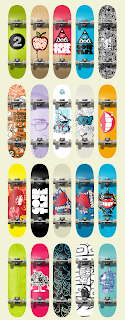Here are some examples of the work of Jared Nickerson (J3 Concepts).
The way that J3 Concepts has crossed a variety of platforms is really cleaver and suits his style, which often consists of repeating patterns. There are a lot of different ways that he has put his work out there aimed at young trendy geeky gadget loving skateboarding design conscious persons.
There seems to be a glimpse at an undercurrent of a hint towards a cool retro subculture in a lot of j3’s work. Taking subtle yet iconic images and jumbling them up in to a pastiche of subdued and at the same time vibrantly colourful art works.
The use of retro cool items in his work will draw the attention of niche consumers to his collection of work and the fact that it is digital art means that its relatively simple to recreate the art work on to any format or platform. The message that he is selling to the viewer is to buy in to the unique blend of stylised iconography to enhance your life style. If you like his style then some of the cool stylish uniqueness will reflect upon you.
What is the importance of understanding ones own design process?
When producing artwork it is important to follow a design process to create a interesting and intelligent solution that fits the brief.
My process starts with trying be be aware of what is going on in the design world, what is trendy and now, and having the ability to draw influences from my environment and collect visual information which I can then use.
It is important to start by understanding the brief and the clients objectives in order that the end product is appropriate . Once I am clear with the brief I then do research and come up with some initial ideas, which once discussed can be developed. I consider my target audience, my intended message, imagery and choice of media. I have learnt to find a natural stopping point so I don't carry on researching and developing ideas for ever.
This is an example of my work explaining the process I followed:
The brief; re-brand this logo for thisisgreenliverpool.com
There was no other information given so the first thing that was done was to speak to the client and bounce some ideas off their team. I then received an email with some images that they found interesting and thought that I might be able to work from. I also did my own research split in to two categories, firstly working from the images that they sent and then working from my own ideas.
I also made sketches and mind mapped ideas with the intention of emailing them to the client to make sure that we were on the same wavelength. After getting some positive feed back and agreeing on the direction they wanted to follow I then moved onto some mock-ups to get ideas for colour and fonts.
I sent the client a number of different designs and colour mock-ups and made adjustments to there specifications. The finished image was agreed upon and the design was sent to the client in their chosen file type.
By communicating with the client and critically appraising my own ideas and listening to their feedback I was able to create a logo that the client was pleased with.
































